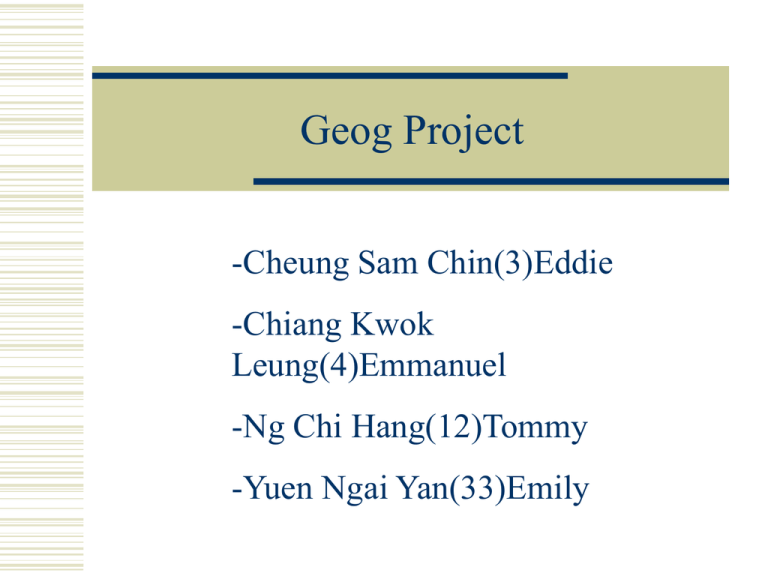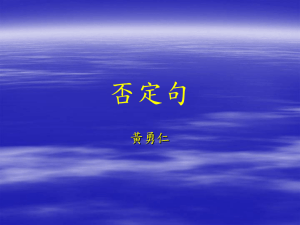Chang Jiang
advertisement

Geog Project -Cheung Sam Chin(3)Eddie -Chiang Kwok Leung(4)Emmanuel -Ng Chi Hang(12)Tommy -Yuen Ngai Yan(33)Emily Geographical Background of Chang Jiang Geographical Background of Chang Jiang China has over 50 000 rivers. The total flow is over 2 600 000 million m3 .The Chang Jiang and the Huang He are the two longest rives in China. The Chang Jiang originates at an elevation higher than 5500 m and flows through 11 administrative regions in to the East China Sea. With a total length of 6300 km, the Chang Jiang is the longest rive in China. It has a drainage area of 1.8 million km2. Physical Division of Chang Jiang Physical Division of Chang Jiang The upper course : It extends from the source to Yichang in Hubei, and it has a length of 4512km.Here the Chang Jiang flows along the Qingzand Gaoyuan ,Yungui Gaoyuan and Sichuan Pendi. The channel slope is steep. Its volume increases as it receives water from the tributaries. The middle course : It extends from Yichang to Hukou in Jiangxi. It has a length of 983km. Here the channel slope is gentler. It is fed by the water from the Han Shui, the Dongting Hu and the Boyang Hu systems. Physical Division of Chang Jiang The lower course : It extends from Hukou to its mouth .It has a length of 850km. It is almost at the sea level. How do Chang Jiang benefit human activities? Rivers provide water for our consumption. Agriculture is the dominant consumer of China’s water resources. Rivers also provide water for residential and industrial uses. As the cheapest means of transportation, river transport is important for moving goods and people. The Chang Jiang provides 70% of the country’s annual water transits of both freight and passengers. How do Chang Jiang benefit human activities Hydro-electric power uses the running water to produce electricity. Rivers, especially in their upper course. And great potential for H.E.P. generation. In the Chang Jiang Basin , over 20 000 H.E.P. stations of varying scale have been built . How do Chang Jiang benefit human activities? Aquatic products of rivers can be sold for profit. The Chang Jiang can also provide money from tourism. Rivers and lakes are breeding grounds for various freshwater aquatic products which provide people with an important source of protein and added variety in our diet. The Chang Jiang Basin has high output of naturally grown freshwater aquatic products. Causes of flooding in Chang Jiang (natural factors) Water melted form snow in spring , heavy monsoon rain in summer and prolonged rainfall brought by extreme weather conditions cause flood in the Chang Jiang. The Chang Jiang obtains heavy load from mass wasting and soil erosion in the upper course. Deposition that has taken place downslopes will make the gentle channel even shallower, increasing the risk of flooding. Causes of flooding in Chang Jiang (human factors) Trees increase interception, and prevent soil erosion and silting on riverbeds. Deforestation is the major cause of frequent flooding in the Chang Jiang Basin. Over-cultivation and overgrazing lead to serious soil erosion, causing a high sediment content to the Chang Jiang and so increasing the change of flooding. The lakes along Chang Jiang Causes of flooding in Chang Jiang (human factors) Lakes can regulate river flow and relieve silting of the river. The reclaiming of the major takes along the Chang Jiang has directly led to the flood problem. Many dykes and dams along the Chang Jiang are either old or needing maintenance. Causes of flooding in Chang Jiang Urbanization increases the rate of deforestation and reclamation of lakes. Besides, more areas of are covered by impervious concrete. There are also more buildings. All these increase the surface runoff. The risk of flooding becomes higher. Background of the Three Gorges Project Background of the Three Gorges Project It is a large-scale water project constructed to achieve a number of aims. Flood control is usually the primary objective in the long run. In 1993, the Chinese government started the Three Gorges Project. The core of the project is constructing the Three Gorges Dam (Sanxia Ba) at Sangouping in Hubei Province. It aims to prevent the flood hazard in the middle and lower Chang Jiang by improving the flood control standard. Location of Three Gorges project Location of Three Gorges project Flood control The arguments the Three Gorges Project -Flood control Pros 1.Regulating the river flow by the dam . 2.huge flood storage capacity of the reservoir Cons: 1.Possibility of floods on the tributaries in the upper course 2.Silting of the reservoir The arguments the Three Gorges Project Power generation Pros 1. Producing a largest amount of renewable H.E.P. Cons 1.high construction cost 2.H.E.P. is not the only choice Resettlement of people The arguments the Three Gorges Project Agriculture Pros: 1.Providing irrigation water by the reservoir Cons: 1.Flooding of farmlands in the upper course 2.Lowering fertility of farmlands in the lower course Resettlement Pros: 15million people will be better off Cons:1.13million people have to resettled Local culture and tourism The arguments the Three Gorges Project Local culture and tourism Pros: removal of historical relics new landscape will create new tourist attractions Cons: ruining of historical sites and the natural scenery local tourism will be affected The arguments the Three Gorges Project Environment Pros: creating a new fishing ground by the reservoir replacing 50million tonnes of raw coal to be burnt annually by H.E.P. Cons: threatening rare and endangered aquatic species increasing risk of landslides by deforestation inducing tectonic movement by the weight of the water collapse of the dam Navigation The arguments the Three Gorges Project Navigation Pros: faster, cheaper and safer shipping on the river Cons: hindering navigation by heavy silting The South-to-North Water Transfer Scheme The South-to-North Water Transfer Scheme Water is an important resource for human society . To cope with the water shortage problem in North China, it is neccessary to transfer water from the south to north. The South-to-North Water Transfer Scheme Reasons The Chang Jiang Basin has abundant water resource. Financially, with the rapid economic growth in the past two decades, there is enough capital for the Chinese Government to carry out large projects. Technologically , the scheme has been subject to long-term and detailed research The South-to-North Water Transfer Scheme The South-to-North Water Transfer Scheme, linking the Chang Jiang with the Huai He, the Huang He and the Hai He, aims to divert water from the south of the country to the drought-striken north. The scheme includes three water transfer projects:the Western Water Project, the Middle Water Project and the Eastern Water Project. The benefit of the scheme The South-to-North Water Transfer Scheme optimises the distribution of water resources in China, relieving North China from chronic water deficit. It also strengthens the flood control capability of the Chang Jiang and ensures the navigation of the BeijingHangzhou Grand Canal. The problems bought by the scheme Decrease in water resource of the Chang Jiang Salinization of quality Impact on the water quality Impact on aquatic life Resettlement of local people Other measures to deal with the water problem Other measures to deal with water problems logging ban afforestation returning land to lakes. China strengthening the flood prevention capacity of rivers. Conclusion Although the Chinese have done many measures to deal with the water problems in Chang Jiang.The water problems are still exist.The measures can minimize the effect bought by the problems, but it also bought another problems to us .So, the Chinese should put more efforts on solving the water problems. THE END







